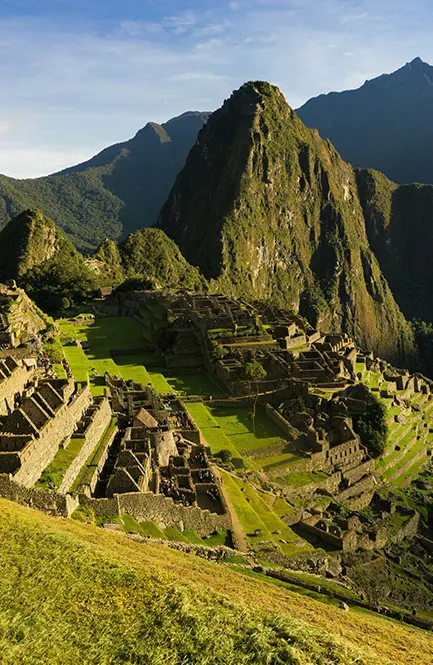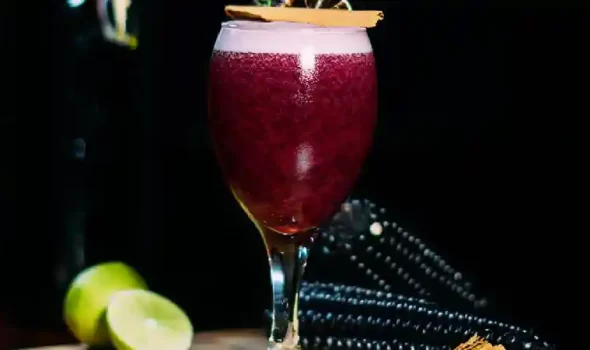We are sure that you are aware of the popularity of gastronomy in Peru. However, another important point that you have to know is the variety of Peruvian drinks that you can find. Auri Peru shows you a list of the famous Peruvian drinks among which you can choose.
As an ideal complement to your experience, each of these traditional Peruvian drinks have been made with local ingredients from each place. Join us and learn more about this alternative for your trip in 2024.
We recommend you see: Discover The Benefits Of The Peruvian Superfoods
BEST PERUVIAN DRINKS:
1.- Pisco Sour
The Pisco Sour is one of the best Peruvian drinks, in addition to being the favorite appetizer for many, it is much more than a simple cocktail: it is an emblem of national identity and a reflection of the rich history and culture of Peru.
Origin and Ingredients
Its origin dates back to the 19th century, when European immigrants arrived on the Peruvian coast in search of opportunities. It was at that moment that the idea of combining pisco, a distilled grape spirit of Spanish heritage, with lemon juice, egg white and gum syrup was born. This fusion of ingredients gave life to a unique drink that quickly conquered both local and international palates.
Preparation process
The preparation of Pisco Sour is a ritual. It begins with the careful selection of the pisco, which can be of the quebranta, acholado or italia type, each with its own aromatic and flavor characteristics. Then, the pisco is combined with fresh lemon juice, obtaining a perfect balance between citric acidity and sweet flavor. The egg white is added to give it a smooth, foamy texture, while the gum syrup completes the mixture with a touch of sweetness, finishing with a touch of Angostura bitters, which is delicately poured over the white foam.

Pisco Sour
2.- Chicha Morada
Chicha Morada is one of the traditional Peruvian drinks that contains in its colors and flavors a long history of tradition and culture.
Origin and Ingredients
Its origin dates back to the ancient pre-Inca civilizations that inhabited the Peruvian Andes, where purple corn was considered a sacred food. Its production mainly takes place in the valleys and its particular purple color makes it unique in the world. This peculiar color is due to the presence of anthocyanins (cyanidin-3-glucoside). In its preparation, accessories such as fruits, cinnamon and more are also considered.
Preparation process
The preparation of Chicha Morada begins with the slow and delicate cooking of purple corn in water, along with pieces of pineapple, pineapple peel, cinnamon and cloves. This process releases the intense pigments and flavors of purple corn, dyeing the liquid a deep dark purple and flavoring it with fruity and spicy notes. The process ends by sifting the liquid into a jug or directly into the glass and it is sweetened with sugar. Its particular flavor has given it the recognition of being one of the famous Peruvian drinks that everyone wants to try.

Chicha Morada
3.- Inca Kola
The first thing you should know is that Inca Kola has a unique flavor and is one of the best Peruvian drinks. It is not only a refreshing soda, it is a cultural icon that has left an indelible mark on the history and palates of its people.
Origin
Its origin dates back to 1930, when José R. Lindley, a British immigrant, decided to create a soft drink that captured the vibrant and colorful spirit of his beloved Peruvian land. Inspired by the cantuta flower, a flower native to the Peruvian Andes, Lindley created a soda with a unique, sweet flavor with a touch of herbs and spices, which quickly became a nationwide favorite.
The best way to consume it
The best way to delight Inca Kola is cold and straight from the bottle or can. Opening a bottle of Inca Kola releases a sweet, enticing aroma that evokes childhood memories and celebrations. For this reason, it is also the perfect companion to enjoy after Creole or homemade food.

Inca Kola
4.- Chicha de Jora
Chicha de Jora, one of the oldest and most emblematic Peruvian drinks in the country, is much more than a simple corn fermentation; It is a living testament to the rich Andean history and culture that has endured throughout the centuries.
Origin
Its origin dates back to the pre-Inca civilizations that populated the Peruvian Andes thousands of years ago. Corn, a crop revered for its nutritional and spiritual importance, was used by these ancient civilizations to create a wide variety of foods and beverages, including Chicha de Jora.
Preparation process
Chicha de Jora begins with the selection of the best jora corn kernels, a variety of large, starchy grain corn. The grains are soaked in water for several days, allowing them to germinate and begin to release their natural starches and sugars. The sprouted grains are then ground and cooked in hot water, creating a thick liquid known as “masa.” This is allowed to cool and ferment in large clay containers called “rachises”, where the yeasts and bacteria present in the environment begin the fermentation process. Over several days or weeks, Chicha de Jora ferments slowly, developing a complex flavor and slight effervescence. In the end we filter out any solid waste that may be present and the result is a slightly alcoholic drink that is used for celebration purposes even today in the communities of the Andes.

Chicha de Jora
5.- Emoliente
Emoliente, a comforting and nutritious drink originating from Peru, is much more than a simple infusion; It is an elixir that contains centuries of history and tradition in every sip.
Origin and Ingredients
Its origin dates back to pre-Columbian times, when the ancient inhabitants of the Peruvian Andes discovered the health benefits of a mixture of herbs and roasted grains. Over time, this drink became a pillar of traditional Andean medicine, used to treat a variety of ailments and ailments. Among the most common ingredients are barley, linseed, horsetail, alfalfa, boldo, and other aromatic herbs.
Preparation process
In a container of water, these ingredients are boiled and combined, releasing their nutrients and beneficial compounds. Once the infusion reaches its optimal point, it is strained to eliminate the solids and sweetened to taste with sugar. This is one of the popular Peruvian drinks that you can find on the streets of any city and even more so on cold nights.

Emoliente
6.- Chicha de Quinua
Chicha de Quinua is one of the traditional Peruvian drinks that are very nutritious. It is a drink that fuses tradition with innovation, celebrating the flavors and nutrients of one of the region’s most revered grains: quinoa.
Origin
Its origin dates back to the ancient pre-Inca civilizations that inhabited the highlands of the Andes. Quinoa, considered a sacred food by these cultures, was grown and consumed in religious ceremonies and rituals of gratitude to Pachamama (Mother Earth). Over time, quinoa became a pillar of the Andean diet, valued for its high protein, vitamin and mineral content.
Preparation process
The preparation of Chicha de Quinua begins with the selection of the best quinoa grains, which are washed and soaked to eliminate impurities and the natural bitter flavor. The grains are then cooked in water until tender and allowed to cool. It is then mixed with fresh water and left to ferment for several days in clay containers called “rachis”. During this fermentation process, yeasts and bacteria present in the environment transform the natural sugars of quinoa into alcohol, creating a slightly alcoholic and effervescent drink.

Chicha de Quinua
7.- Barley Mate (Cebada)
Barley Mate, a comforting and nutritious infusion originating from the Peruvian Andes, is one of the Peruvian drinks that has lasted through the centuries, rooted in the rich history and traditions of the region.
Origin
Its origin dates back to ancient pre-Inca civilizations, where barley was cultivated and revered for its resistance and nutritional value. Over time, this humble seed became a fundamental ingredient of the Andean diet, used in a variety of dishes and drinks, including Mate de Cebada.
Preparation process
Preparation begins with the selection of the best barley grains, which are lightly roasted to enhance their flavor and aroma. The roasted beans are then ground and slowly cooked in water, releasing their nutrients and beneficial compounds. Once the barley has boiled sufficiently, it is strained to remove the solids and served hot in a cup.

Barley Mate
8.- Frutillada
Frutillada, It is one of the delicious and refreshing famous Peruvian drinks in the Cusco region, it is a true culinary treasure that fuses the freshness of fruits with the natural sweetness and creativity of Peruvian cuisine.
Origin and Ingredients
Although frutillada does not have as old a history as some other Peruvian drinks, its popularity has grown rapidly in recent decades, typical of the town of Yucay by families who migrated due to water scarcity, becoming a refreshing and nutritious option for hot days.
Preparation process
The preparation of the frutillada begins with the selection of the strawberries as the main and protagonist ingredient. These are washed, disinfected and cut into small pieces to release all their flavor and juiciness. The strawberries are then combined with other fresh, natural ingredients, such as freshly squeezed lemon juice, sugar or honey, and cold water. This mixture is placed in a blender and processed until obtaining a smooth and homogeneous consistency and then served in glasses.

Frutillada
9.- Coconut water
Coconut Water, a refreshing and rejuvenating Peruvian beverage, has its roots in the tropics and has become an elixir revered around the world for its naturally sweet flavor and numerous health benefits.
Origin
Its history dates back to ancient times in the tropical regions where coconut palm trees grow. For centuries, coastal communities have valued coconut as a vital source of food and water, especially in hot, humid climates where hydration is essential for survival.
How to consume it?
Coconut consumption is simple and direct. It begins with the harvest of fresh coconuts, which are carefully selected for their ripeness and freshness. Once selected, the coconuts are skillfully opened to reveal the precious liquid inside. It is transparent and slightly sweet, it is carefully extracted and poured into containers or bottles for consumption. It is often served fresh and cold, straight from the freshly opened coconut, to preserve its natural flavor and nutrients.

Coconut water
10.- Maracuyá Sour
The Passion Fruit Sour, an exotic and delicious variant of the classic Pisco Sour, fuses the acidic and exotic freshness of passion fruit with the smoothness and complexity of Peruvian pisco, creating a unique and memorable flavor experience. It is currently considered one of the famous Peruvian drinks that everyone wants to try.
Origin and Ingredients
The origin of the Passion Fruit Sour dates back to the rich tradition of Peruvian mixology, where the Pisco Sour has reigned as the king of cocktails for decades. However, with the arrival of passion fruit to Peruvian lands, mixologists and drink lovers saw an opportunity to add a fresh and tropical touch to the classic favorite. In its ingredients we can see that they are the same as pisco sour with the addition of passion fruit juice.
Preparation process
The preparation of Passion Fruit Sour begins with the careful selection of ripe and juicy passion fruits, whose pulp is extracted and mixed with pisco, fresh lemon juice and gum syrup in a shaker. This mixture is shaken vigorously with ice until well combined and refreshingly cold. The presentation of the Passion Fruit Sour is an important part of its charm. Served in a pre-chilled cocktail glass, garnished with fresh passion fruit or a lemon wedge on the rim to add a touch of color and freshness.

Maracuyá Sour
11.- Coca tea
Coca tea is one of the traditional Peruvian drinks, an emblematic infusion of the Peruvian Andes, it is much more than a simple drink: it is a symbol of the rich culture and traditions of the region, as well as a reflection of the ancestral relationship between Andean peoples and the coca leaf.
Origin
Its origin dates back to ancient times, when pre-Inca civilizations used the coca leaf for medicinal and ceremonial purposes. Over time, this practice became an integral part of Andean culture, and Mate de Coca became a drink revered for its ability to increase energy, alleviate altitude sickness, and promote general health and well-being.
Preparation process
The leaves in the best condition are carefully selected for their quality and flavor and are combined with hot water in a container to be served later. It is also possible to crush them and turn them into powder, this is used as a base for the infusion.

Coca tea
12.- Masato
Masato, a traditional Peruvian drink consumed in various indigenous cultures of the Amazon, is more than a simple infusion: It is a symbol of community, celebration and connection with nature.
Origin and Ingredients
With a history dating back to pre-Columbian times, Masato has been an integral part of the traditions and rituals of the indigenous Amazonian peoples for centuries. Originally, it was made from the fermentation of cassava or bitter cassava, but over time, various variants have been developed that include other ingredients such as corn, rice or plantain.
Preparation process
The preparation of Masato begins with the collection and preparation of the main ingredients, which may vary depending on the recipe and region. Cassava or bitter cassava is peeled, washed and boiled until tender, then pounded or ground to extract its juice and starch, which will be used as a base for the drink. Water is added to the juice obtained and sweetened to taste with sugar or honey. In some variants, other ingredients such as corn, rice or banana can be added, which are cooked and added to the mixture to provide additional flavor and texture.

Masato
13.- Cusqueña beer
The Cusqueña beer is a treasure of the country, fusing the rich brewing tradition with the majesty of the ancient capital of the Inca Empire. With a history dating back decades, these beers have conquered the palates of locals and travelers alike, offering a unique and memorable flavor experience, thus becoming one of the famous Peruvian drinks that you must try on your trip.
Origin
The origin of Cusco beers is found in the rich brewing tradition of the region, which dates back to the time of the Incas. The Incas, famous for their mastery of agriculture and fermentation, used grains of barley and corn to make a variety of alcoholic beverages, including fermented corn chicha. With the arrival of the Spanish and the introduction of European beer, the brewing tradition in Cusco began to evolve and adapt to new ingredients and brewing techniques. Among its carefully selected ingredients, including high-quality barley malt, hops and yeast, as well as pure water from the springs of the Andes.
Preparation process
The preparation of Cusco beers is a meticulous process that combines tradition with innovation. Barley grains are ground and cooked to extract their sugars, which are then fermented with yeast to produce alcohol and CO2. Hops are added during the boiling process to impart bitterness and aroma, while Andean water ensures the purity and quality of the beer.

Cusqueña beer
14.- Craft beer
Craft beers are a manifestation of the passion and creativity of brewers, who seek to create unique and memorable flavor experiences through traditional methods and innovative recipes. With a history dating back thousands of years, craft beers have their roots in ancient civilizations that brewed beer around the world using local ingredients and rudimentary fermentation techniques.
Origin and Ingredients
The history of craft beers is a story of resistance and resurgence. For many centuries, beer was an integral part of daily life in communities around the world, but with the advent of industrialization and mass production, many local breweries were closed or taken over by large corporations. However, in the late 20th and early 21st centuries, there was a revival of interest in craft beers, driven by a growing demand for variety, quality and authenticity. The ingredients used vary by recipe and style, but typically include barley grains, hops, yeast, and water. Additionally, craft brewers often experiment with a wide range of additional ingredients, such as fruits, spices, herbs, and other grains, to create beers with unique and complex flavors.
Preparation process
The preparation of craft beers is a careful and laborious process that requires meticulous attention to every detail. The grains are ground and cooked into a mixture called wort, which is boiled and hops are added to impart bitterness and aroma. Once cooled, the wort is transferred to fermenters, where yeast is added to start the fermentation process, which can last from a few days to several weeks or even months, depending on the style of beer.

Craft beer
15.- Chilcano
Chilcano Clásico is one of the Peruvian drinks that combines tradition with innovation. With a history dating back to the early 20th century in Lima, Peru, this cocktail has conquered the palates of locals and visitors alike, becoming an undisputed favorite in bars and restaurants around the world.
Origin and Ingredients
The origin of Chilcano is attributed to bartender Victor Morris, who used to work at Morris’s Bar in downtown Lima. Morris is said to have created this cocktail as a Peruvian version of the popular “Moscow Mule,” adapting the recipe with local ingredients and a touch of creativity. It also contains traditional ingredients such as pisco, fresh lemon juice, ginger ale or ginger beer, and ice.
Preparation process
In a tall glass with ice, pour a generous portion of pisco, followed by a measure of freshly squeezed lemon juice. Then, the cocktail is completed with ginger ale or ginger beer, which adds a spicy and effervescent touch to the drink, mixed gently with a bar spoon to ensure that all the ingredients are perfectly integrated. It can be decorated with a slice of lemon or a sprig of mint to give a final touch of freshness and presentation.

Chilcano
FLAVORS OF PERU THAT ARE NEVER FORGOTTEN:
“Deep in the Andes and discover vibrant fruits of untold worth, today you can share this delight, Peruvian drinks, a heritage so bright!”
16.- Papaya Juice
Papaya juice is one of the delicious and refreshing Peruvian drinks that is traditionally enjoyed for breakfast, prized for its sweet and gently creamy flavor, as well as its numerous health benefits.
Origin
Native to the tropical regions of Central and South America, papaya has been cultivated and consumed for centuries, and its juice is a popular way to take advantage of the nutritional properties it contains.
Preparation process
It begins with selecting ripe, juicy papayas, which are peeled and the seeds discarded. The papaya pulp is cut into pieces and placed in a blender along with cold water and, optionally, a little sugar or honey can be added to sweeten. The mixture is blended until smooth and homogeneous, and then strained to remove any bits or fiber that may remain. The result is a silky and vibrant juice, with an intense orange color and a tempting aroma.

Papaya Juice
17.- Golden Berry Smoothie (Aguaymanto)
The Golden berry smoothie is one of the most exquisite and nutritious Peruvian drinks that has its roots in ancient Peruvian culture and has become a culinary gem appreciated around the world.
Origin
Native to the Peruvian Andes, aguaymanto, also known as “golden berry” or “uchuva”, has been cultivated and consumed for centuries due to its sweet flavor and nutritional properties.
Preparation process
It begins with the selection of ripe and juicy Aguaymantos, which are carefully washed and disinfected. These small, vibrant fruits are added to a blender along with other fresh, natural ingredients, such as milk, yogurt or water, and honey or sugar can optionally be added to sweeten to taste. This can be enjoyed cold as a refreshing summer drink or even with crushed ice for an extra touch of freshness.

Golden Berry Smoothie
18.- Algarrobina cocktail
The Algarrobina cocktail is one of the traditional Peruvian drinks that combines the cultural richness of the region with the natural sweetness and unique flavor of Algarrobina, a legume native to the coastal valleys of Peru.
Origin and Ingredients
With a history that goes back decades, this cocktail has conquered the palates of cocktail lovers, becoming an icon of Peruvian gastronomy. To make it, you need the pulp of carob pods, pisco, evaporated milk, fresh eggs, sugar and cinnamon.
Preparation process
These ingredients are carefully combined in a shaker with ice and shaken vigorously until well combined and chilled. Preparing carob cocktails is a meticulous process that requires precision and attention to detail. Once the mixture is ready, it is poured into previously cooled glasses and sprinkled with a touch of cinnamon powder to enhance its aroma and flavor.

Algarrobina cocktail
19.- Lúcuma cocktail
The lucuma cocktail is one of the delicious and exotic Peruvian drinks with the unique flavor and versatility of lucuma, a fruit native to the Peruvian Andes. Lucuma is a fruit with an intense yellow pulp and a flavor that evokes notes of caramel, vanilla and hazelnut. To prepare a lucuma cocktail, the pulp of this fruit is used, which is combined with other fresh and natural ingredients to create a refreshing and delicious drink.
Origin and Ingredients
With a history that dates back to ancient times, lucuma has been appreciated for its nutritional properties and natural sweetness, becoming an iconic ingredient in Peruvian gastronomy. The main ingredients of the lucuma cocktail usually include fresh or frozen lucuma pulp, pisco, a Peruvian grape distillate, fresh lemon juice, sugar syrup or honey, and ice.
Preparation process
Preparing the lucuma cocktail is a simple process but requires precision to achieve the perfect balance of flavors. These ingredients are combined in a shaker and shaken vigorously until well mixed and chilled. Once the mixture is ready, it is served in previously chilled glasses and can be decorated with a slice of lemon or a mint leaf for a final touch of freshness.

Lúcuma cocktail
20.- Maracuyá cocktail
Passion fruit cocktail, also known as passion fruit cocktail, is one of the refreshing and exotic Peruvian drinks that captures the vibrant and tropical essence of passion fruit, a fruit native to South America.
Origin and Ingredients
With a history dating back to the rainforests of the Amazon region, passion fruit has been appreciated for its unique flavor and nutritional properties for centuries, becoming a popular ingredient in the cuisine of various countries. To make it, you need fresh passion fruit pulp, white rum or pisco, a Peruvian grape distillate, fresh lemon juice, sugar syrup or honey, and ice.
Preparation process
In a cocktail shaker, add the rum or pisco, passion fruit juice, sugar or honey syrup and fresh lemon juice. After shaking it with ice, it is ready to be served in a previously chilled glass. You can decorate it with a lemon wedge on the rim of the glass and a mint leaf on top, if you wish.
| “Discover the rich, exotic flavors of Peruvian drinks, unique fruits, grains and herbs passed down through generation” |

Maracuyá cocktail
The best company for a good meal is one of the Peruvian drinks that contain not only flavor but also tradition. Contact Auri Peru today and discover a new adventure for 2024.
“Man cannot discover new flavors unless he has the decision to visit new countries.”




















